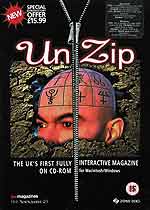
Digital magazines: news and a history timeline
by Tony Quinn
It can seem as if digital magazines appeared suddenly, but attempts at creating such a medium go back to the 1980s. This timeline sets out UK developments in hardware, software and published product. A separate page covers digital magazine software developers.
Showing the way to go (early 1980s)
- electronic mail (e-mail);
- Teletext 'magazines'
- Prestel-based bulletin boards
- Micronet
Digital production (late 1980s)
- magazines use DTP
CD-Rom magazines (mid 1990s)
- video-based CD-Rom magazines
- CD-Roms as cover-mounts on mainstream titles
Websites (mid-1990s)
- Newspapers and magazines launch websites
Online digital magazines (mid-1990s)
- online PDFs
- adding interactivity
- online – a new channel for magazines
Brand extension (early-2000s)
- mobile phone and TV channels
Online-only digital magazines (mid-2000s)
- Dennis launches Monkey
- News-stands on the web for digital magazines
- Customer publishers adopt digital format
- Apple iPad and other tablets try to take hold
Development of digital media
| Date | Event | Details |
|---|---|---|
| 1971 | Project Gutenberg | Volunteer-run archive for digital books, founded by Michael S. Hart |
| 1982 | Magazines start to use electronic mail and online noticeboards | Acorn User (Addison-Wesley) uses Dialcom, the world's first commercial email system, with ID ACN014 (and later RED001 at Redwood Publishing). This later becomes Telecom Gold. Phone line access through a 300/300 bits/s acoustic coupler, into which phone handset plugged |
| Dial-a-horoscope service from Woman and BT | Woman's managing editor Betty Hale reads out daily horoscopes on Starline premium phone line. Jilly Collins, the magazine's astrologer, sent out 32-page computer printouts from another number. In a week, the London phone service took 25,000 calls. It aimed for 3m a year | |
| Cover disc – vinyl | Your Computer (December) 33.3 rpm vinyl single holding Sinclair ZX81 games | |
| Publishers start to use computer networks | Acorn User and contract publisher Redwood throws out typewriters in favour of Econet system and Acorn BBC Micros. Copy written on networked BBC terminals, stored on 5.25in floppy discs or 5MB network hard drive and printed on centralised daisywheel or dot matrix printers to be sent to typesetters. Redwood continued to use the system – which grew to about 80 terminals – before switching to Macintoshes running Quark XPress |
|
| 1983 | Subscription-based online bulletin boards using viewdata systems (broadcast by TV stations or over telephone lines) | Viewdata systems consisting of several hundred 'pages', each of 24 characters by 20 lines of text (1K in size):
|
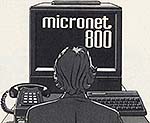 |
Emap launches Micronet 800 based at 8 Herbal Hill in London's Clerkenwell. Magazines, individuals and organisations set up their own pages using Prestel. Subscribers used Prism 1200/75 baud (down/up speed) modem | |
| Thousands of computer users run their own Prestel-based bulletin boards from home, office or school using BBC Micros, modems and phone lines |
||
| 1984 | DTP on Apple Macintosh | Postscript-based digital technologies for typesetting, page layout and image manipulation. Publishing software 'holy trinity': Quark XPress for DTP; Photoshop for image editing; Illustrator for vector graphic images: Apple Macintosh (1984) Postscript from Adobe (1984) Apple Laser Writer printer (1985) Aldus Pagemaker for PCs (1985) ISO defines SGML (1986) Adobe Illustrator (1987) Quark Xpress (1987) Adobe PhotoShop (1989) |
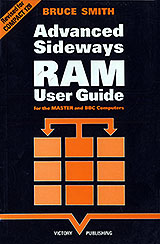 |
Writers start to publish their own books from wordprocessor files using daisywheel or dotmatrix printers to produce pages, rather than having the text typeset. Examples include:
|
|
| Big K publishes 'Shatter' | 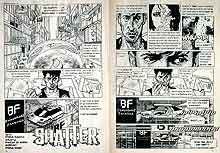 Comic strip in issue 12 (March 1985) drawn on an Apple Macintosh. Claimed to be a world first. By Mike Saenz, Peter B. Gillis and Mike Gold. A one-off comic Shatter was published in the US a year later |
|
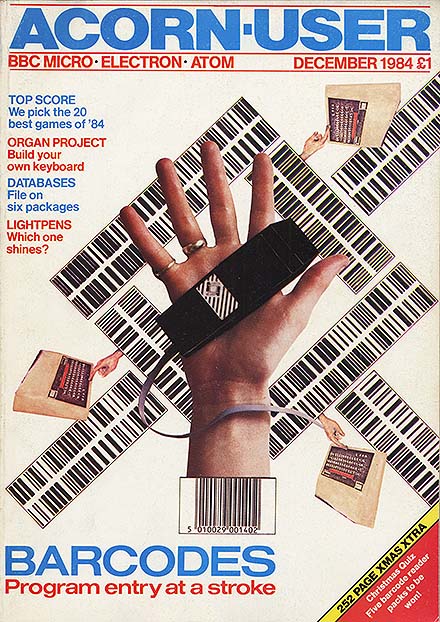 |
Acorn User magazine supports the bar code reader project run by the government’s Microelectronics Education Programme by printing its program listings as bar codes. Owners of the reader could scan in the listings rather than having to type them in. The readers were mainly bought by schools to run IT projects and school libraries | |
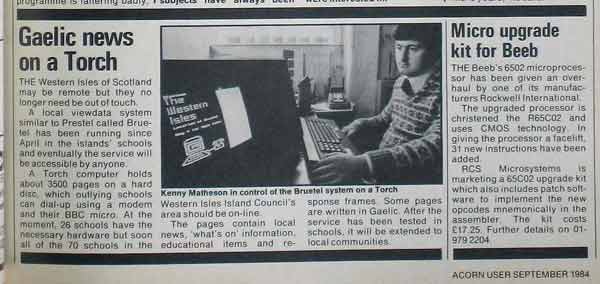 Schools in the Outer Hebrides on the west coast of Scotland had access to a dedicated viewdata system in 1984 Schools in the Outer Hebrides on the west coast of Scotland had access to a dedicated viewdata system in 1984 |
||
| 1985 | Acorn Computer takes delivery of first ARM (Acorn Risc Machine) chip | 26 April 1985. Steve Furber and Sophie Wilson at Acorn Computer take delivery of first ARM (Acorn Risc Machine) chip. ARM becomes the first Risc (Reduced Instruction Set Computer) chip to power a mainstream microcomputer – the 32-bit Acorn Archimedes. Apple licenses ARM development system – and later ARM Ltd is spun out of Acorn with Apple's help. 'ARM chips are cheap and fast, and consume so little power that – as the company demonstrated in a neat stunt with a thermocouple – you can run one off a Pentium's waste heat.' 'Hermann Hauser's Second Chance' by Christopher Anderson, Wired, May 1996 |
| The 'Great Prince Philip Prestel Mailbox Hack' | Robert 'Bug Hunter' Schifreen, 21, and Stephen Gold, 29, become first people tried for hacking, and are convicted under the 1981 Forgery and Counterfeiting Act. On appeal, the House of Lords rules that typing in someone else's password was not the same as forging a signature and they are acquitted. Hacking not made illegal until 1990 | |
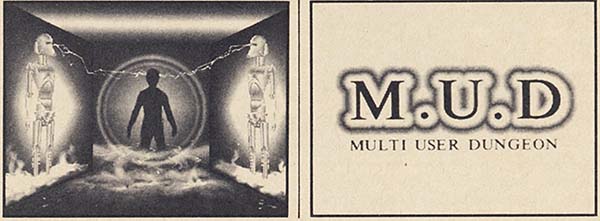 A MUD starter pack cost £20. The first three hours were free, after that it cost £2 an hour plus the phone charges (about 40p an hour at local rates) A MUD starter pack cost £20. The first three hours were free, after that it cost £2 an hour plus the phone charges (about 40p an hour at local rates) |
||
| BT launches MUD – Multi-User Dungeon – world's first commercial online game and forerunner of today's massive multiplayer games | Book publisher and Acorn User competition editor Simon Dally forms a company with Roy Trubshaw and Richard Bartle to promote MUD, a multi-user dungeon game. The game was launched with British Telecom as the first online multi-user MUD. He told Acorn User editor Tony Quinn he found the Vax minicomputer to run the game in a builder's skip. Computer magazine Popular Computing Weekly quoted Dally in May 1985: 'I know the BT venture is just the start of something truly enormous.' Indeed, it was key to the development of today's massively multiplayer online games | |
| The Hacker's Handbook becomes bestseller | Simon Dally at Century Communications launches hacking guide by Hugo Cornwall (a pseudonym of Peter Sommer). Scotland Yard condemns its publication. The book sells 75,000 copies over four editions until it is withdrawn because of the 1990 Computer Misuse Act |
|
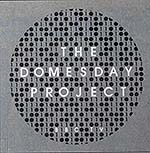 |
1986: The BBC and Philips try to establish a standard for interactive video discs with the BBC Domesday system. This was made up of a Laservision player – using double-sided, 12-inch optical discs – controlled by a BBC Micro. The software pioneered many aspects of multimedia presentation, such as virtual rooms and objects that could be 'walked around' | |
| Growth at Micronet 800 | Micronet has 30,000 pages on Prestel. In January, it sets a record with each one on average accessed 10 times a day – 9.5m page accesses in the month, making it the most popular area of Prestel. About 20,000 people 'on the Net' | |
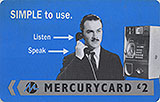 |
Telecoms shakeup: Mercury Communications had been running business landlines for two years in a bid to compete with BT when it rolled out payphones in 1986. Comedian Harry Enfield was the face of its TV advertising and on the phone cards with a 'simple to use' message delivered in the style of a 1950s public information film |
|
| 1990 | Computer hacking made illegal | Computer Misuse Act brought in. Fearing prosecution for incitement by Scotland Yard's computer crime squad, publishers Random Century withdraw The Hacker's Handbook from sale |
| 1991 | BT closes Micronet | Having merged Micronet and Prestel into Dialcom and then Telecom Gold, in October 1991 BT closed all its online services, having passed subscribers to Compuserve (later AOL) |
| 1992 | Adobe Acrobat PDFs | Adobe launches Acrobat portable document format |
| World-Wide Web being developed | Economist: 'Researchers at CERN in Geneva are trying to build a ... World-Wide Web (or W3), drawing on their experience in helping physicists find their way around the mountains of data produced by CERN's accelerators.' ('When computers merge', 20 June) | |
| Jonathan Ive joins Apple | Jonathan Ive leaves London design agency Tangerine, of which he was a co-founder, for a job with Apple, a client | |
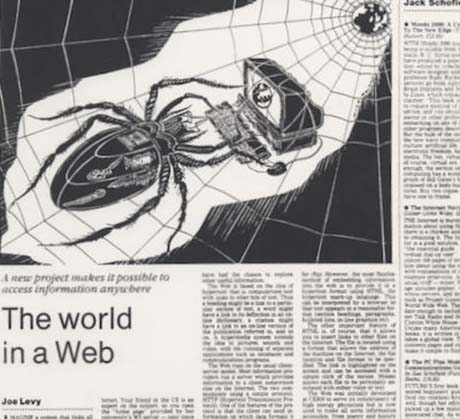 First article about the WorldWide Web First article about the WorldWide Web |
||
| 1993 | 11 November: Guardian article about the World Wide Web | The Guardian's Computer section (p19) carries an article 'The world in a web' by Joe Levy of Edinburgh university describing the World Wide Web project at CERN. The article gives a Telenet address for information and an FTP address for the Mosaic browser at NCSA |
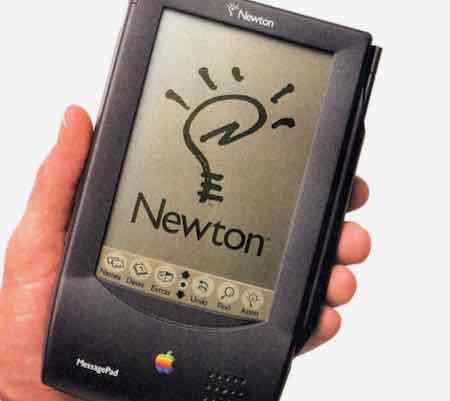 Apple Newton personal digital assistant based around ARM (Acorn Risc Machine) chip Apple Newton personal digital assistant based around ARM (Acorn Risc Machine) chip |
||
| Apple launches Newton personal digital assistant based on the ARM 610 RISC processor | The Apple Newton was an early tablet. Like the iPad 17 years later, it was based on an ARM RISC processor, in this case ARM 610, and used handwriting recognition software. Acorn founder Hermann Hauser leads consortium to develop rival ARM-based EO personal digital assistant, which is later sold to AT&T. Neither device was a success and each is reckoned to have cost its backer £50m. The Newton had a role in the 1995 Steven Seagal film Under Siege 2: Dark Territory, where the action hero uses one to send a fax to the Pentagon through a phone on a train |
|
| 1994 | Newspapers move to the web | Daily Telegraph claims to be first national newspaper on the web |
 |
Unzip CD-Rom from IPC and software developer Zone UK used content from New Musical Express, Vox and New Scientist in 1995. It cost £15.99 and had a sales target of 20,000. Only one edition was published. The CD-Rom lacked the depth (and cheapness) of a magazine, the visual quality of TV or the excitement of a computer game | |
| Internet magazine launches | Future's .Net and Emap Computing's Internet cover the internet and WorldWide Web (December). Many come with cover discs for free online access |
|
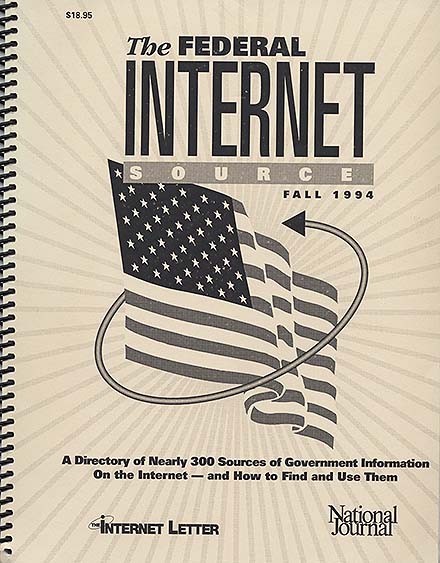 |
Publisher releases the Federal Internet Source, a quarterly spiral-bound directory of US federal websites (ending in .gov) – 300 of them, including pages for the White House and the CIA. Go to the Magforum blog to read more. | |
| 1995 | CD-Rom magazines | At least 10 available (Baumann 1995). Blender, a US title distributed by Dennis in the UK at £9.99 based on samples of US bands and film trailers, and Unzip, 'the UK's first fully interactive magazine on CD-Rom' (IPC) |
| CD-Rom cover mounts on non-computer magazines |
August issue of men's monthly Maxim (Dennis Publishing) | |
| Websites for mainstream magazines | Uploaded.com (Loaded, IPC); nme.com (New Musical Express, IPC) | |
 8 August 1995: Microsoft sponsors a free issue of The Times newspaper in a launch 'extravaganza' for its Windows 95 graphical operating system 8 August 1995: Microsoft sponsors a free issue of The Times newspaper in a launch 'extravaganza' for its Windows 95 graphical operating system |
||
| Microsoft launches Windows 95 | To mark the new operating system, Microsoft sponsored free copies of The Times and a 28-page supplement in the paper on August 24 1995. A worldwide launch 'extravaganza' included wine-tastings at shops in Auckland, a helicopter dropping the first consignment in South Africa, and journalists in Poland being taken out in a submarine 'to sample life without windows'. | |
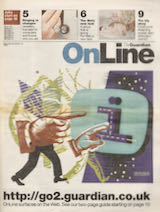 |
Guardian puts Online supplement on the web as Go2 website from 16 November 1995. Inside, Alan Rusbridger, editor of the Guardian, said: 'The last time the newspaper industry ever had to cope with anything like this was when Johann Gutenberg came up with the concept of movable type in 1450 ... No one can put their hand on their heart and swear that there will be such things as newspapers in 25 years.' |
|
| 1996 | Electronic auditing | ABC Electronic established to provide independent certification for data related to electronic media |
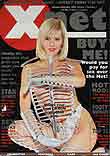 |
X-Net bi-monthly came with a CD-Rom at £7.95 for 100 pages. It featured popular pin-up Jo Guest and hundreds of addresses for pornographic as well as sport, comedy and car websites. The CD-Rom held more than 300 links to websites and used the sales line: 'Babe Fest! Interview the girls, then watch them strip.' It caused a furore, to which its editor, Dominic Handy, responded in the Guardian: 'We did not go out to publish a porn mag, we wanted to publish Loaded for the internet.' | |
| Whitehouse website archived | The US White House website launched in 1993, but the oldest version on the Web Archive is dated 27 December 1996. By 1997 there was a White House tour led by Socks, the Clintons' cat. When Clinton lost the presidency in 2001, Socks was adopted by his secretary, Betty Currie, who took the cat to live with her in Virginia | |
| Internet World and Internet Today launches | September launches for VNU's Personal Computer World spin-off and a Paragon title marketed as ‘UK’s first internet magazine’. Floppy disc on cover gives access to AOL (America On-Line internet access provider) |
|
| 1997 | Digital kiosks | BT Touchpoint with NME, Loaded and Marie Claire content |
| Improving technology meant CD-Rom titles could market themselves based on their video content. Among the first publishers to exploit this development were those behind top-shelf titles such as X-Net and Enter (below) | ||
| Niches develop for magazines about the web |
Future launches Internet Works | |
| 1998 | Sunday Times CD-Rom cover mount | Windows on the World was an educational CD-Rom produced with the British National Space Centre |
| 1999 | New media expansion | BRAD (Nov) directory lists 668 entries under 'new media' |
| Web magazine niches develop | Haymarket launches The Net consumer title. BBC distributes free magazine Webwise as part of its web literacy support programme. Web 'taster' sessions held at 5,000 venues across the UK |
|
| Nuvo Media's Rocket e-Book | Portable e-book device for $300 that held about 4,000 pages (10 books). Owners could buy copyrighted digital versions of books and journals | |
| Mini CD-Rom | SAP advert in Management Today includes tip-on business-card-sized mini CD-Rom (October, p27) | |
| Demon ISP contract magazine | Intenet service provider (ISP) launches free magazine @demon (autumn). Contract title by Haymarket Magazines covers 'technology to improve your life', news groups, home pages and travelling with your own mobile office | |
| 'e-' is suffix of the year | Marketing Week in the UK and later Newsweek in the US launch 'e-' spin-offs: E-Volve (May) and E-Life respectively. The former was aimed at the new specialism of digital marketing and E-Life was a special quarterly (one-off?) dedicated to 'the best stuff for your family' (Winter). Computer-generated mouse Stuart Little from the film is on the cover. The iMac had launched in August 1998 but the 'i' suffix would not be popularized by Apple until the iPod in 2001 and iPhone in 2007 |
|
| 2000 | CD-Rom magazines based on video content | Enter monthly from Pure Communications. Lads' mags with advertising from Toyota, Heineken, Mars and Jameson whiskey. The CD-Rom included a video of actress Amanda Holden |
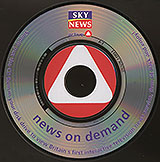 |
Sky News launches Active, a news on demand system that claims to be 'Britain's first interactive television news service'. 'Sit back and enjoy!' Was the message on this mini-CD promotion |
|
| Project Gutenberg grows | Free library holds 2,000 ebooks | |
| Microsoft launches Reader software using ClearType for PCs and laptops |
Company predicts in a timeline on its website (dated September 13 1999) and in advertising that: a 'slate form' Tablet PC would be a mainstream device by 2004; eNewstands would 'proliferate on street corners' by 2006; by 2008 ebook titles would 'begin to outsell conventional volumes in most countries'; two years later companies would be giving away ebook devices; and by 2020, the primary dictionary definition of a book would be writing displayed on a computer. Barnes & Noble.com and Microsoft open eBookStore for Microsoft Reader (www.bn.com). Michael Crichton's Timeline was free to download. Other promoted books for sale included Lethal Seduction by Jackie Collins, Married to Laughter by Jerry Stiller and Deadly Decisions by Kathy Reichs. Online magazine Salon was sceptical. Microsoft's timeline was taken down by 2001 |
|
| 2001 | Digital facsimile editions of newspapers start to appear | 'Flat PDFs' with no interactivity |
| Web developer magazines | March: Web User fortnightly with advice from the Plain English Campaign July: Web Active monthly from VNU November: Webspace monthly |
|
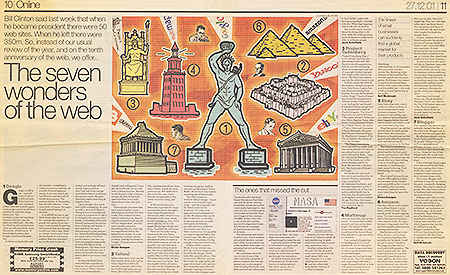 Guardian's magnificent seven websites Guardian's magnificent seven websites |
||
| Guardian picks 'Seven wonders of the web' | The magnificent seven websites are: Google; Yahoo!; Project Gutenberg; Multimap; Ebay; Amazon; and Blogger. Nearly-rans were: the BBC; Friends Reunited; Microsoft; Nasa; Tranexp translation website; MacTutor history of maths; Slashdot; Need to Know; and Dnausers, which listed every airline crash. (Guardian Online, 27 Dec 2001, pages 10-11) |
|
| 2003 | SMS text messaging | |
| US software developer Zinio founded | ||
| Online media now mainstream | BRAD (Jun) no longer lists websites separately | |
| Sunday Times CD-Rom supplement | The Month CD-Rom is based on entertainment and arts content. It was sponsored by Renault for a reported £250,000. The first time the disc was loaded, a 40-second Renault advert was shown. After that, users could skip the ad halfway through. Commercial deals included a website with MVC where users could order reviewed CDs; and a link to Warner Village's website to book cinema tickets online |
|
| 2005 | Financial Times launches digital facsimile edition | Includes How to Spend It |
| Digital paper announced |
||
| 2006 | Teenagers go digital | Emap closes Smash Hits. The name lives on as a digital music TV channel and radio station, online and as a mobile phone service. Switch in teenage spending to online and mobile-phone-based media blamed for teen title closures |
| Digital (facsimile) magazines | Exact Editions launches first titles (Feb). Quickly expanded to include Dazed & Confused | |
| Downloadable magazines for phones | Time Out, OK!, Glamour, GQ on Mobizine platform (Feb) | |
| Magazines launch on YouTube | Condé Nast puts Glamour, GQ and Vogue magazines on YouTube | |
| YouTube seen as affecting (men's) magazines | 'Unloaded, and now the party is over,' (Brown, 2006) | |
| Magazines use YouTube for marketing | Nuts men's weekly (IPC) celebrates sales results with a raunchy ad on YouTube | |
| Temporary video websites exploiting social networking | Zootube.co.uk for Emap's Zoo men's weekly | |
| TV magazines cover online films and podcasts | Radio Times covers YouTube, iFilm and Google Video on radiotimes.com and in magazine | |
| Interactive digital-only magazines launched | Monkey from Dennis. 'The world's first weekly digital men's magazine' (Nov) | |
| Media organisations launch special editions in Second Life online world |
US technology title Wired (October); German tabloid Bild (December); Sky News (May 2007); CNET, Reuters, BBC Radio 1 and Channel 4 Radio (Green 2007) | |
| 2007 | Radio Times adds streaming guide | Weekly TV guide magazine revamps its website to help find shows on the web for downloading |
| First ABCe figures for digital-only and print magazines | Monkey releases ABCe of 209,612 copies a week | |
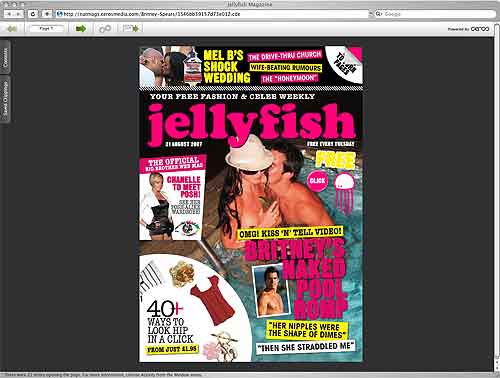 |
||
| Digital-only magazine for teenagers | National Magazines launches Jellyfish as a trial using Ceros technology. The magazine's motto was 'if it moves, click.' However, problems with the emailed files being blocked because of poor mailing lists led to the experiment failing and it was closed within 6 months. | |
| Contract publishers seek ABCe audits for digital titles | River Publishing registers Healthy for Men with ABCe (May) | |
| 'No one has got the business model for online cracked yet' | Advertising revenue rising but 'no one has got the business model for online cracked yet,' Stevie Spring (chief executive, Future Publishing) | |
| '[Newspapers] have yet to find monetisation models' | '[Newspapers] have yet to find sound monetisation models' (Richard Stephenson, chairman of Yudu Media, quoted by Kirby 2007) | |
| Magazines move into digital TV | Nuts TV channel based on the weekly IPC men's magazine (September) | |
| Free weekly men's magazine launched with website | ShortList gives away 500,000 copies. 'Our site is completely central to everything we're planning' Mike Soutar, quoted in Dorrell, 2007 | |
| Online digital facsimile newsagents launched | MyMag Online in Ireland | |
| DVD magazine announced | 'The world's first' magazine on DVD from Expansive Media (expansivemedia.com) (for November launch) | |
| Publishers working with digital paper |
E-Ink working with Time magazine (Moses) |
|
| 2008 | Digital magazines becoming an established medium | Exact Editions has about 70 titles; Ceros 200. In February 2008, Zinio launches Global Newsstand to make 850 titles available to buy and read online |
| ARM ships its 10-billionth chip core | ARM chips are reckoned to power 85% of the world's mobile phones and are so ubiquitous that production exceeds the population of the planet | |
| Brand expansion for Monkey | Dennis Publishing and mobile media company Player X launch Monkey as a free mobile TV channel (March) | |
| Dennis builds on Monkey business model | Dennis launches fortnightly iMotor and Gizmo | |
| Monthly car launch | Motor Play (motorplay.co.uk) launches as a free digital car monthly 'with over 200 pages of beautifully produced articles on cars' | |
| Social applications and widgets for Stuff website | Umee (http://umee.tv/) develops utilities such as Twitter, Facebook and Clearspring widgets for Haymarket's Stuff.tv | |
| Wallpaper widget | News feed and a photo of the day from monthly design title |
|
| 2009 Sept | PixelMags iPhone app launched | App from US developer allows print publications downloaded to a mobile device to be Audit Bureau of Circulation accredited |
| iPhone app from NME |
IPC's music weekly sells 59p app to access band photographs using Umee technology. Rebrands itself as: online, magazine, TV, radio, mobile (note the order) | |
| FT drops digital fascimile technology for How to Spend It | Financial Times relaunches online version of its large-format luxury monthly magazine How to Spend It. Razorfish uses Adobe Flash 10 to translate 'the glossy magazine reading experience into a convincing luxury online environment' |
|
| 2010 | January: IPC spins off magazine from website | IPC Connect, the women's division of IPC Media, launches monthly cookery magazine, Goodtoknow Recipes as a spin-off from its web portal, Goodtoknow.co.uk |
| February: Dennis closes monthly motoring emag iMotor | Dennis blames e-mag's lack of success on the economic downturn and that it had 'found it hard to convince manufacturers to make full use of the creative environment that a digital magazine offers'. Monkey and iGizmo not affected | |
| April: iPad launch in the US May: Apple launches the iPad in the UK. Claims 300,000 sales on the first day. | Newspapers and magazines such as Wired, The Spectator and the Financial Times release iPad apps to read their stories in a format that tries to mimic the printed page. The FT wins 'best iPad app' award for its free offering, which is downloaded 150,000 time in 3 weeks; the August edition of Press Gazette gave the total as 250,000 (p6). iPad screen is 9.7 inches diagonally, compared with the iPhone's 3.5in | |
| May: VW releases free customer magazine as iPad app | DAS (Digital Automotive Space) also set up as a website in June. The plan was to publish the app quarterly in five languages across Europe | |
| Economist hails mobile-phone-based magazine sales strategy | Readers elect to receive mobile text message summarising the main stories from the issue about to go to press. They can then buy that issue by replying, triggering a charge to their credit card. Issue is then delivered overnight. Magazine reports operating profit had climbed 3% to £58m with copy sales at 1.4m a week. | |
| August: Dazed & Confused released as free app for Apple iPhone, iPad and iPod Touch | Dazed co-founder Jefferson Hack said: 'From fold-out poster to iPad app, Dazed has come a long way since its birth almost two decades ago. With the new app, a whole new audience of culturally aware iPad and iPhone users will be introduced to Dazed.' The digital magazine was based on Exact Editions Precisely platform | |
| September: iPad 'changing the rules of digital publishing' | A report on the Yudu website suggested people were spending far more time browsing the iPad app for GQ and Vanity Fair than they were the websites (from 2-4 minutes a month to 60) | |
| Segmentation of digital publishing strategies | Publishers talk of discrete digital channels:
|
|
| Wired iPad app sales plummet | Sales fall from 100,000 in June to about 28,000 in August for the Adobe-based app | |
| Apple reported sales at the end of September of more than 8m iPads. Goldman Sachs expects Apple to ship 37m iPads in 2011 | ||
| FT combines print and digital sales | Evidence of digital segmentation with the Financial Times announcing combined global print and digital paid-for circulation measure to be released each quarter. This is in addition to print data from the Audit Bureau of Circulation. At the same time, the paper withdrew from ABCelectronic. 'We aren't a volume site so we are looking to measure ourselves against registered users and subscriptions,' FT deputy director of communications Tom Glover told Magforum | |
| Poll on magazine reading/browsing in 2020 | Exact Editions ran an online survey in October 2010 asking people's opinions about their future reading habits, How will we read magazines? | |
| iPad advertising revenue | Financial Times deputy chief executive Ben Hughes tells Campaign (15 October 2010, P12) iPad app has generated more than £1 million in advertising revenue since it launched in May. More than 400,000 subscribers had signed up for the app and it accounted for one in 10 of the newspaper's new digital subscriptions. In total, paying digital subscribers had risen by half in a year to 189,022. In addition, FT.com had three million registered users. Daily print circulation was 401,898. The paper began accepting Paypal as well as credit cards | |
| December:Seven launched Project, a monthly a magazine app, for Virgin. At the New York launch, Virgin Group founder Richard Branson stressed the advertising potential: 'It's a truly interactive digital magazine ... it's going to make advertising a hundred times more efficient.' 'You can even play with the adverts.' | ||
| Oppolis analysis shows more than half of reviewers had a problem with an iPad app | At the launch of its GoMobile tablet publishing software, Oppolis showed the results of a survey of 800 reviews of iPad magazines. Among the results were:
|
|
| Kindle 'is bestseller' on Amazon says Bezos, though he does not state figures | Amazon founder and chief executive Jeff Bezos said: 'We're grateful to the millions of customers who have made the all-new Kindle the bestselling product in the history of Amazon – surpassing Harry Potter 7 [Deathly Hallows].' [Amazon.com lists HP7 as its 80th bestselling book.] 'We're seeing that many of the people who are buying Kindles also own an LCD tablet. Customers report using their LCD tablets for games, movies, and web browsing and their Kindles for reading sessions. They report preferring Kindle for reading because it weighs less, eliminates battery anxiety with its month-long battery life, and has the advanced paper-like Pearl e-ink display that reduces eye-strain, doesn't interfere with sleep patterns at bedtime, and works outside in direct sunlight, an important consideration especially for vacation reading. Kindle's $139 price point is a key factor -- it's low enough that people don't have to choose.' |
|
| 2011 | Researchers say iPad sales are hitting PC sales | In a report on PC sales, described in the FT, IDC reckons 'Growth steadily slowed throughout 2010 as weakening demand and competition from the Apple iPad constrained PC shipments'. The FT backs this up with a Gartner study, saying: 'IDC and Gartner, in separate reports issued on Wednesday, said total shipments were less than previous projections.' IDC estimates that about 17m tablets were shipped by manufacturers in 2010, most of them from Apple, and that figure is expected to reach 44m in 2011, alongside 385m PCs. |
| Feb | Murdoch launches The Daily, an iPad newspaper | News International chief joined by Apple executive Eddy Cue (stepping in for Steve Jobs). 'A newspaper that's both old-fashioned and cutting-edge' that will sell for 99 cents a week or $40 a year. |
| June 7: Financial Times launches web-based app based on HTML5 for smartphones and tablets, bypassing Apple. Works on Android phones and Motorola Xoom as well as Apple products | FT avoids need to go through iTunes – which has credit card details for 225m people. Plays off 30% take by Apple against app store's ease of use, but FT chief John Ridding stressed need for 'direct relationship with customers' after publishers expressed concern at Apple's reluctance to share data on the identities and behaviour of people buying apps through its shop. International Newsmedia Marketing Association voiced concern in February about rules from Apple relating to content subscriptions on iPhone and iPad. Rob Grimshaw, MD of FT.com, said the FT had no plans to pull out of any apps store, but would encourage users to adopt the web app with a marketing campaign, including a week's free access | |
| July: Dennis launches Padder – a fortnightly magazine app about the iPad | Launch advertisers included News International, Battlefield 3, Intel and Just Mobile. First issue free, £1.19 after that | |
| ARM ships its 10-billionth chip core |
||
| 2012 | Online advertising £4.8bn in 2011 | Internet Advertising Bureau UK estimates online advertising increased 14.4% to £4,784 million in 2011 (April 2). This is the biggest sector, worth 27% of all ad spend. TV was 26% and press (display and classified) 25%. Online video doubled to £109m |
| Digital magazine software reviews (Feb 2012) | .Net magazine reviews 10 ways to make digital magazines, including Google Currents; Treesaver; Baker framework; Laker Compendium; Kindle Publishing; Adobe Digital Publishing Suite; WordPress; Magaka; doing-it-yourself; and Facebook | |
| May | Technology Review says publishers don't like apps | Online MIT magazine is dumping apps and following the Financial Times down the HTML5 route (May 2012) |
| June | French digital newsstand Lekiosk launches app in English (renamed as Cafeyn) | 600 titles for any tablet, smartphone or computer |
| June | Huffington Post launches iPad version | Huffington is the name for the weekly iPad magazine at Apple's app shop |
| July | FT has more digital subscribers than newspaper sales | FT global audience is 2.1m people worldwide |
| Aug | Growth of Twitter – but with mixed results | Snapshot on 30 Aug: Dazed and Confused on Twitter has 405,000 followers with 13,675 following; Grazia has just 122,000; British Vogue 731,000 with 1,161 followers, but just 877 following |
| Oct | BBC shuts off the analogue TV signal – the end of the Ceefax viewdata system after 30 years | Northern Ireland is last part of UK to receive analogue, says BBC
|
| Contract publisher uses Layar augmented reality app technology | Dutch customer media publisher Label has used the Layar augmented reality app in its own publication Labelmag to demonstrate interactive print. AR apps can recognise an object seen through a smartphones or tablet camera and use it to trigger a link to a website or video or game. Other platforms include Blippar and Aurasma, which is part of Autonomy | |
| MailOnline overtakes NY Times traffic in US | Aggressive Dail Mail offshoot focuses on celebrities with a home page that looks like popular German daily Bild |
|
| Dec 2012 | Murdoch shuts iPad paper, The Daily | The Daily, needed about 500,000 subscriptions at $0.99 a week or $39.99 a year to break even, but only achieved 100,000 and was losing $30m a year |
| US weekly Newsweek stops publishing print edition |
||
| 2013 | February. PPA combines ABC circulation figures for print and digital editions | PPA, the magazine industry trade body, quoted Condé Nast MD Nicholas Coleridge: 'Digital editions of magazines are more and more important as an exciting and viable addition to print. It is essential that these are fully recognised by the ABC, if our circulations are to remain accurate and coherent.' Glamour came out top with 428,325 (4,248 digital), then Good Housekeeping (412,704; 3,378). Men's Health was the digital leader at 12,676 (215,380 in print), one of five titles to exceed 10,000 |
| June | Magazines go online only as sales falls take toll on print | Auto Trader announces last print edition after circulation fall from a peak of 368,000 in 2000 to 27,000 in 2013. Women's monthly More had been closed by Bauer in April and Condé Nast's 2005 launch Easy Living went online only in May. Mumsnet ran a thread on the closure |
| June | Under the headline 'Growing love for digital magazines', the Guardian reports that 'half the British population have bought and read digital magazines', based on research by lekiosk, a digital newsstand app | |
| July | Future launches royal baby app | Future launches a commemorative app with the Press Association days ahead of the birth of the Duke and Duchess of Cambridge's first child. The iPhone and iPad app is free to download, but sells special sections, 'chapters', for 69p each. It claimed to be the first such app to feature photography of the new arrival |
| August | Digital magazines: how popular are they? | The Guardian analyses PPA data on digital sales compared with print |
| October | Swedish magazine app launches in UK | Readly, an app that aims to be the 'Spotify of magazines', offers 120 titles, such as Marie Claire, The Lady and Time Out for an 'all-you-can-read' fee of £9.99 a month |
| June 2015 | Apple announces it is planning to reduce the 30% charge it makes on publishers' app sales. It also announced a Flipboard clone | |
| June | Apple announces it is building the potential to block adverts into the next release of its iPhone operating system | |
| July | The Times launches Irish digital edition | Seven-day digital newspaper for tablet, phone and desktop users in Ireland and a digital edition of The Sunday Times |
| September | Time Inc UK decides to turn NME into a freesheet |
|
| Feb 2016 | Owner announces that the daily Independent and the Independent on Sunday are to go online only. However, Trinity Mirror launches a new daily tabloid, New Day with no website | |
| March | Condé Nast buys editorial technology company. London-based Poetica has developed software for editing articles in real-time | |
| April | Irish website launches print edition | The Dublin Inquirer, a website covering politics, arts, culture and food in the Irish capital, launches itself as a monthly newspaper |
| Feb 2017 | Time Inc in US to sell services | 'When you think about our 30m subscribers, we only sell them magazines today. If you think about the opportunity to sell other things to those customers, it's substantial,' said Jen Wong, Time Inc's operating chief. Pet health insurance 'sounds niche, but it's not really. There are a lot of pet owners. It's a big opportunity and a great service model' |
| March | Ministers urged to investigate Google and Facebook over fake news | The News Media Association (NMA), which represents newspapers and magazines, says that fake news, spread largely through social media, is threatening genuine news publishers and accurate investigative journalism |
| April | Journalists' trade paper Press Gazette starts a campaign after a report that, by 2020, Google and Facebook could take 71% of UK digital advertising | |
| April | Ebooks suck, says the Telegraph | News that sales of consumer ebooks licences fell 17% in 2016, to the lowest level since 2011, while book sales were at a five-year high, prompted the paper to write: From baths to bookshelves: 10 reasons ebooks suck |
| May | Free digital magazines through libraries | Cheshire West and Chester Libraries makes 40 digital magazines available, free of charge, to library card holders through Unique Magazines and Magzter, a digital news-stand |
| June | The Times launches print edition in Ireland | Following the success of its Irish digital edition since September 2015, for the first time, The Times launches a print edition distributed from two printing plants in Ireland |
| July | Google funds digital journalism software development | Web search and advertising giant gives £300,000 to City University to write an app to help journalists use 'big data'; and £560,000 to the Press Association to develop software to write 30,000 stories a month for local media. Part of a £100m, three-year scheme it says aims to help journalism survive |
| October | Zinio 'the world's biggest digital newsstand' | Claims '5,500 magazines on any device' |
| October | Guardian gambles £42m on media tech incubator | Media group to spend £42m of its £1bn endowment fund backing companies involved in 'next generation of media technology' |
| November | Libraries push digital magazines | Suffolk Libraries is among the services pushing its digital stocks such as Cosmopolitan, Good Food, Top Gear, New Scientist and Practical Photography. People who commute into Suffolk or live in Cambridgeshire, Norfolk and Essex can get a library card |
| January 2018 | Readly signs up 19 Dennis magazines | Magazine subscription platform to host Men's Fitness, Pc Pro, Evo, Fortean Times, Viz and Minecraft World but not flagship The Week |
| March | Apple buys Texture, a digital magazine subscription service | Texture was set up in 2010 by US publishers Condé Nast, Hearst, Meredith and Rogers Media, and KKR, a global investment firm. It handles 200 titles, including People, Elle, Hello!, Esquire and The New Yorker |
| June | Readly's digital magazine report identifies best-read titles | Company's top 10: Hello!, OK!, Heat, Closer, Autocar, Bella, Woman, Woman's Own, Best and Now. UK consumers read 13m digital magazines in 2017, up 80% on a year earlier. This ranked the UK 3rd worldwide after Germany (23m) and Sweden (19m). The UK had the highest number of titles available, at 1,009 |
| October 2020 | Effect of the coronavirus on magazines | New Scientist editor Emily Wilson: 'We've completely changed our business, all from our bedrooms' |
| July 2021 | MailOnline is top UK media website | Page view totals at Ipsos Iris: MailOnline 518m; Sun 335m; Guardian 305m |
| July 2021 | 50 years of Project Gutenberg |
Free library holds 60,000 ebooks |
| Jan 2022 | Record ebook library loans | Overdrive, a US digital distributor, announces that 506 million ebooks, audiobooks and digital magazines were checked out by readers in Covid-hit 2001. Toronto Public Library is the first library to check out 9m digital publications. Libraries from 7 countries reached the million mark |
| Back to top | ||
Bibliography |
||
|
||



